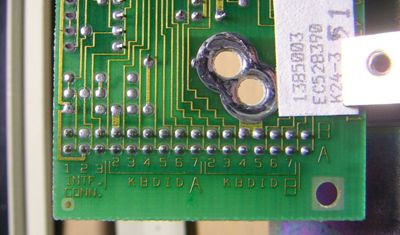The microcontroller in that has a Zenith copyright sticker. The PCB is marked "12KC397A / Alps Made in Japan / Heath P/N: 163-16". It also has all the keynumbers silkscreened onto it, and a "diode" symbol by each one. As well as the LEDs in the Num Lock and Caps Lock keys, it's also got a piezo speaker that simulates keyclicks.
Ah, so it's a OEM Zenith that was made by Alps, wouldn't have guessed that. I love the idea of having keynumbers on the PCB, every 'board with a PCB should have them. Added keyclicks though can be annoying or fun, depending on the individual user.
I have the same keyboard. It's a terminal emulation board, but it's meant more for an AS400 than for a mainframe.
Hm, hence 3270 / 5250 surely? Or have I inflamed some sort of Poughkeepsie vs Rochester thing (yikes...)?
I can't honestly take any credit for anything except my ability to put together a keyboard cord (a very mediocre one at that). All credit should go to John Elliott for those fantastically helpful webpages. Alexander at kbdbabel should get some credit too for the inspiration (and also for the pinouts; I like to check pinouts from multiple sources before I trust them, and indeed I did find an incorrect AT kb pinout somewhere in my travels of the net. beware, an inaccurate one IS OUT THERE)
Well, you seem to have instigated something. Fresh interest indeed! (You woke me up, anyway...) Certainly no denying John and Alexander's brilliant work in this area, though.
I'll be straight-up honest and say I don't really understand how this causes issues; it seems to me that it would work anyway (but I don't understand how these signals work, what interprets them, etc. I'd greatly appreciate a lesson in keyboard signalling from someone here). Also on "BAT", not sure what that refers to (I'd take a stab and say it's the keyboard identifier sent during initialization).
I was under the impression that the ID was intended to provide a means of classifying different keyboard types, so in theory systems would complain when they come across something they know that they can't support. As the evidence seems to be here that many modern controllers and/or software don't actually care, this may not be such an issue but could still crop up (have you tried one on a PS/2? Perhaps I should do that myself...).
BAT is not an issue, it's the Basic Assurance Test. I thought that the terminal keyboard might return a different value to the accepted norm, but it doesn't.
In any case, bear in mind that personally I was looking at all the potential theoretical issues rather than actually trying anything out, because I was relying on making up a 5-pin 240 DIN socket to 6-pin min DIN plug adapter but never did thanks to other events.
Probably the best grounding in how keyboards operate in relation to their host device can be found at the site I quoted:
http://www.computer-engineering.org/~~~
For interested Brits, these are pretty difficult to find over here... Permanent eagle eyes on the 'Bay might find something, but expect a long wait. All my terminal 'boards have come from the US, with the expection of this 1397003 emulator board from Germany.
UK postal strikes aside, USPS Priority Mail has generally been trouble free, with 'boards getting through customs without any charges and taking about a week, as opposed to anything I've had sent by UPS who never fail to add on charges with comparable delivery times due to the customs delays despite the rapidity of UPS itself.
Also, watch out for the weight difference on the capacitive bucklers ["F"] as opposed to the membrane bucklers ["M"].
~~~
Hi Spec57! Thanks for linking to that, I never did get to doing so.
Rereading that, I see my 5.5mm nutdriver has been lost since April... So long as the hardware store still has them, I will be able to buy a new one on Saturday and will take some pics of the 1397003 PCB

Looking for keycaps
I'm not going to part with any at the moment since I haven't decided what I'm doing, but there may be some available from a
1389260 (also for the 3179) in future.
the DIP switches on the 3270 PC's keyboard (or whatever model is the one that has DIPs, I think it's that).
Yes, the 6110344 has the DIPs (not to be confused with P/N 6110345 which was for the 3180 and has no DIPs). Sandy took some great pics of the PCB of his 6110344 (see
A little bit of keyboards), which suggest that the DIP switches are involved with adjusting the keyboard ID:

(click for bigger version)
Though this image poses more questions that it answers....
There are 8 switches, the connector according to Sandy attaches directly next to the keyboard cable connector and so only allows setting of "KBDID A" 2-7 to and "KBDID B" 2 and 3. Supposing that these are the two bytes of the keyboard ID... the typical byte has eight bits, not six. And is there a 0? Whether the series starts at 0 or 1, is it the least significant or most significant bit? Note also the extra pins beyond the end, are these for another bit or some other purpose? Do the switches set the bits or just flip existing states? Are the PCB markings even relevant to the purpose of the switches anyway? Also note that some of the pins seem to be tied high or low, having attempted to follow the traces.
John, as you have one of these 'boards and seem to have the ability to read reported keyboard IDs, might you be interested in playing with the DIPs?